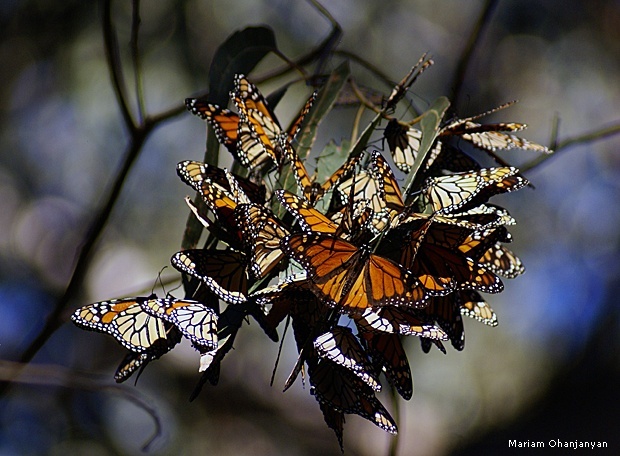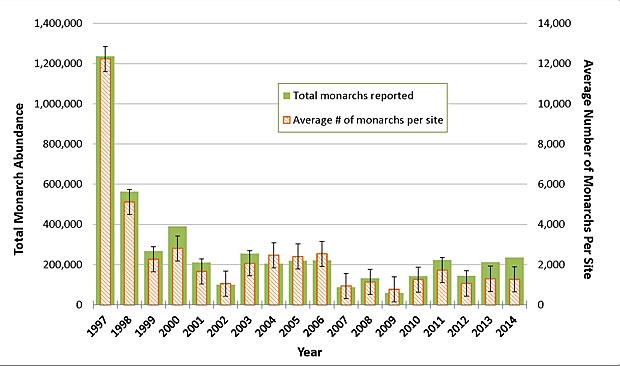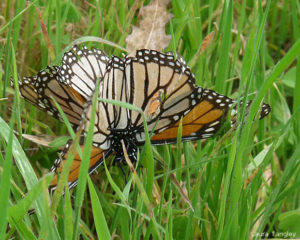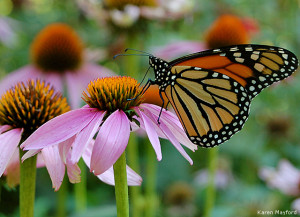We have much more to do and your continued support is needed now more than ever.
Western Monarchs: Why 1 Percent Matters
A sunny, picture-perfect day on the California coast in late February turned even better when I arrived at a tiny sanctuary in Pacific Grove and found the air filled with butterflies—scores of bright, orange-and-black monarchs fluttering among the branches of fragrant eucalyptus and Monterey pine. The scene was spectacular, yet my companion, Ann Wasser of the Pacific Grove Museum of Natural History, told me the butterfly gathering was a mere shadow of what it had been earlier in the season. “We estimate we have about 1,500 monarchs now,” said Wasser, education manager for the museum, which monitors the insects’ numbers. In late November, she said, the 2-acre, city-owned Monarch Grove Sanctuary had sheltered some 24,000 butterflies, the rest having recently departed for summer breeding grounds across the western United States and Canada.

Holding Steady—For Now
Wasser told me the Pacific Grove monarchs “had a very good year.” She and her colleagues counted 10,000 more butterflies than they did during the winter of 2013-2014. Statewide results also were encouraging: At 185 sites along the California coast—where the majority of monarchs that breed west of the Rocky Mountains spend the winter—volunteers with the 2014 Xerces Society Western Monarch Thanksgiving Count tallied 234,732 butterflies, slightly up from the previous winter.
The longer-term picture is alarming, however. Data collected during the 18-year count show a major decline in the number of overwintering monarchs (see graph, below). In 1997, the effort’s first year, volunteers recorded more than 1.2 million butterflies. According to Xerces Society Executive Director Scott Hoffman Black, California’s monarch numbers have declined by 80 percent from this high point and by 48 percent from the population’s average during the 18-year period.

East-West Divide
Researching an article, “Battle for Butterflies,” in the current issue of National Wildlife, I, like most writers covering monarchs, focused almost exclusively on butterflies that breed east of the Rockies and overwinter in Mexico—understandable given that these insects make up 99 percent of the continent’s population. According to Black, the threats facing western monarchs are similar to, but less well documented than, those confronting butterflies in the East and Midwest. Their biggest problems in recent years have been extreme weather and habitat loss, both in the insects’ breeding and wintering territories.
East of the Rockies, by far the greatest—and best documented—single threat to monarchs is massive milkweed losses across the U.S. Midwest, where the majority of North American monarchs breed and produce the next generation. In the West, “we suspect milkweed destruction also is a major factor,” says Black, “but so far we don’t have the smoking gun.” An added challenge facing western monarchs is that winter sanctuaries—strung out along more than 600 miles of coastline—are small and surrounded by development. Many trees the butterflies rely on have died or fallen down. Black says some sites are so degraded monarchs no longer can use them.
“Home-grown” Butterflies

“To me, it’s about genetic diversity,” Wasser says. She cites recent evidence that “the Mexico-California divide is not as absolute as scientists once thought.” That is, some monarchs coming north from Mexico may end up breeding in the West and visa versa. Having a second population that mixes with the first “helps diversify the gene pool,” she adds, “which in turn will help monarchs be better prepared for disease, climate change and other threats coming their way.”
In addition, California’s overwintering monarchs are “nearly 100 percent home grown,” Black notes. They represent the only portion of the continental population where U.S. officials, farmers, gardeners and others “can shape what happens throughout all of the butterfly’s life stages.”
How You Can Help Monarchs

Plant milkweeds native to your region.
Milkweeds are the only plants on which monarch butterflies can lay their eggs. To find out which species are native to your region or to purchase plants, check out Monarch Watch’s Milkweed Market or the Xerces Society’s Milkweed Seed Finder.
Cultivate native, nectar-producing plants.
These food sources are particularly critical during spring and fall when monarch butterflies and other animals are undertaking long migrations.
Avoid pesticides on monarch host and nectar plants.
In particular, steer clear of systemic insecticides such as neonicotinoids, which are taken up by the vascular systems of plants. This means butterflies and other pollinators can be exposed to poison long after a product has been applied by feeding on leaves, nectar and pollen. A new study provides evidence that milkweed leaves treated with one neonicotinoid, Imidacloprid, will kill monarch caterpillars that eat them.
Be a Wildlife Gardener
![]() Help monarch butterflies and other spring migrants by becoming a wildlife gardener.
Help monarch butterflies and other spring migrants by becoming a wildlife gardener.






















